#Sarcopterygii
Text
I recently found out a show I liked is 10 years old now so to not be the oldest thing on this blog I'm talking coelacanths for Wet Beast Wednesday. Coelacanths are rare fish famed for being living fossils. While that term is highly misleading, it is true that coelacanths are among the only remaining lobe-fined fish and were thought to have gone extinct millions of years ago before being rediscovered in modern times.
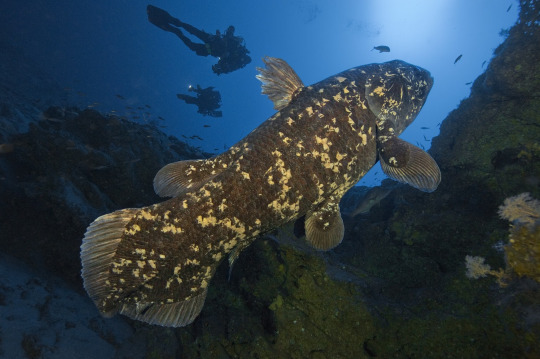
(image id: a wild coelacanth. It is a large, mostly grey fish with splotches of yellowish scales. Its fins are attached to fleshy lobes. It is seen from the side, facing the top right corner of the picture)
Coelacanth fossils had been known since the 1800s and they were believed to have gone extinct in the late Cretaceous period. That was until December 1938, when a museum curator named Marjorie Courtenay-Latimer was informed of an unusual specimen that had been pulled in by local fishermen. After being unable to identify the fish, she contacted a friend, ichthyologist J. L. B. Smith, who told her to preserve the specimen until he could examine it. Upon examining it early next year, he realized it was indeed a coelacanth, confirming that they had survived, undetected, for 66 million years. Note that fishermen living in coelacanth territory were already aware of the fish before they were formally described by science. Coelacanths are among the most famous examples of a lazarus taxon. This term, in the context of ecology and conservation, means a species or population that is believed to have gone extinct but is later discovered to still be alive. While coelacanths are among the oldest living lazarus taxa, they aren't the oldest. They are beaten out by a genus of fly (100 million years old) and a type of mollusk (over 300 million years old).

(image: a coelacanth fossil. It is a dark brown imprint of a coelacanth on white rock. Its skeleton is visible in the imprint)
Coelacanths are one of only two surviving groups of lobe-finned fish along with the lungfishes. Lobe-finned fish are bony fish notable for their fins being attached to muscular lobes. By contrast, ray-finned fish (AKA pretty much every fish you've ever heard of that isn't a shark) have their fins attached directly to the body. That may not sound like a big difference, but it actually is. The lobes of lobe-finned fish eventually evolved into the first vertebrate limbs. That makes lobe-finned fish the ancestors of all reptiles, amphibians, and mammals, including you. In fact, you are more closely related to a coelacanth than a coelacanth is to a tuna. Coelacanths were thought to be the closest living link to tetrapods, but genetic testing has shown that lungfish are actually closer to the ancestor of tetrapods.
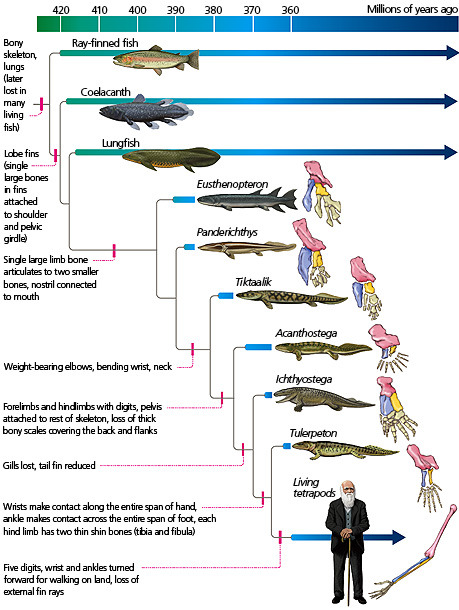
(image id: a scientific diagram depicting the taxonomic relationships of early lobe-finned fish showing their evolution to proto-tetrapods like Tiktaalik and Ichthyostega, to true tetrapods. Source)
There are two known living coelacanth species: the west Indian ocean coelacanth (Latimeria chalumnae) and the Indonesian coelacanth (L. menadoensis). Both are very large fish, capable of exceeding 2 m (6.6 ft) in length and 90 kg (200 lbs). Their wikipedia page describes them as "plump", which seems a little judgmental to me. Their tails are unique, consisting of two lobes above and below the end of the tail, which has its own fin. Their scales are very hard and thick, acting like armor. The mouth is small, but a hinge in its skull, not found in any other animal, allows the mouth to open extremely wide for its size. In addition, they lack a maxilla (upper jawbone), instead using specialized tissue in its place. They lack backbones, instead having an oil-filled notochord that serve the same function. The presence of a notochord is the key characteristic of being a chordate, but most vertebrates only have one in embryo, after which it is replaced by a backbone. Instead of a swim bladder, coelacanths have a vestigial lung filled with fatty tissue that serves the same purpose. In addition to the lung, another fatty organ also helps control buoyancy. The fatty organ is large enough that it forced the kidneys to move backwards and fuse into one organ. Coelacanths have tiny brains. Only about 15% of the skull cavity is filled by the brain, the rest is filled with fat.

(image id: a coalacanth. It is similar to the one on the above image, but this one is blue in color and the head is seen more clearly, showing an open mouth and large eye)
One of the reasons it took so long for coelacanths to be rediscovered is their habitat. They prefer to live in deeper waters in the twilight zone, between 150 and 250 meters deep. They are also nocturnal and spend the day either in underwater caves or swimming down into deeper water. They typically stay in deeper water or caves during the day as colder water keeps their metabolism low and conserves energy. While they do not appear to be social animals, coelacanths are tolerant of each other's presence and the caves they stay in may be packed to the brim during the day. Coelacanths are all about conserving energy even when looking for food. They are drift feeders, moving slowly with the currents and eating whatever they come across. Their diet primarily consists of fish and squid. Not much is known about how they catch their prey, but they are capable of rapid bursts of speed that may be used to catch prey and is definitely used to escape predators. They are believed to be capable of electroreception, which is likely used to locate prey and avoid obstacles. Coelacanths swim differently than other fish. They use their lobe fins like limbs to stabilize their movements as they drift. This means that while coelacanths are slow, they are very maneuverable. Some have even been seen swimming upside-down or with their heads pointed down.
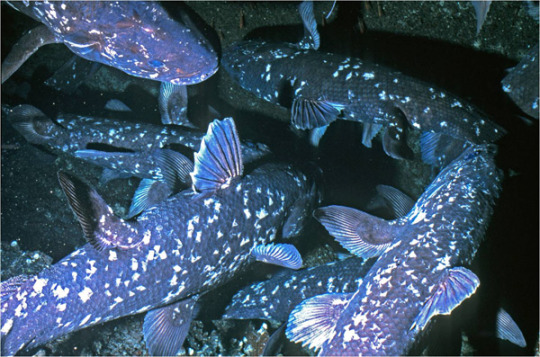
(image: an underwater cave wilt multiple coelacanths residing in it. 5 are clearly visible, with the fins of others showing from offscreen)
Coelacanths are a vary race example of bony fish that give live birth. They are ovoviviparous, meaning the egg is retained and hatches inside the mother. Gestation can take between 2 and 5 years (estimates differ) and multiple offspring are born at a time. It is possible that females may only mate with a single male at a time, though this is not confirmed. Coelacanths can live over 100 years and do not reach full maturity until age 55. This very slow reproduction and maturation rate likely contributes to the rarity of the fish.

(image: a juvenile coelacanth. Its body shape is the same as those of adults, but with proportionately larger fins. There are green laser beams shining on it. These are used by submersibles to calculate the size of animals and objects)
Coelacanths are often described as living fossils. This term refers to species that are still similar to their ancient ancestors. The term is losing favor amongst biologists due to how misleading it can be. The term os often understood to mean that modern species are exactly the same as ancient ones. This is not the case. Living coelacanth are now known to be different than those who existed during the Cretaceous, let alone the older fossil species. Living fossils often live in very stable environments that result in low selective pressure, but they are still evolving, just slower.
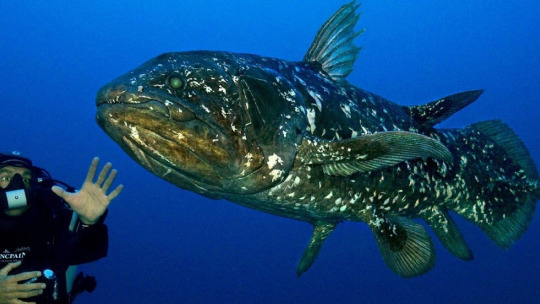
(image: a coelacanth swimming next to a SCUBA diver)
Because of the rarity of coelacanths, it's hard to figure out what conservation needs they have. The IUCN currently classifies the west Indian ocean coelacanth as critically endangered (with an estimated population of less than 500) and the Indonesian coelacanth as vulnerable. Their main threat is bycatch, when they are caught in nets intended for other species. They aren't fished commercially as their meat is very unappetizing, but getting caught in nets is still very dangerous and their slow reproduction and maturation means that it is long and difficult to replace population losses. There is an international organization, the Coelacanth Conservation Council, dedicated to coelacanth conservation and preservation.
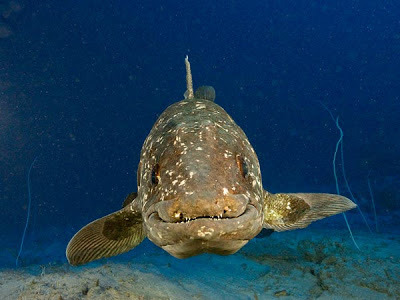
(image: a coelacanth facing the camera. The shape of its mouth makes it look as though it is smiling)
#wet beast wednesday#coelacanth#marine biology#biology#zoology#ecology#animal facts#fish#fishblr#old man fish#lobe-finned fish#sarcopterygii
1K notes
·
View notes
Text

Lungfish sketch :) trying a new brush
#mostly I like the brush but it's very... not quite blurry but kind of shaky#astigmatism simulator 😔#lungfish#fish#lobe finned fish#fish art#aquatic#sarcopterygii#neoceratodus forsteri
118 notes
·
View notes
Text

the guys...
169 notes
·
View notes
Text
If you're new to my tumblr you've probably not seen this process before. I make all of my models for pewter and metal casting by hand. Sometimes it's Monster Clay but my preference is actually for jeweler's wax. I've been carving for at least five or six years now and feel like I'm just now getting really competent at it. This little coelacanth is about an inch and a half long and will be turned into a little freestanding figure and a pendant when done. I've still got a ways to go but all the big shapes are there.
#coelacanth#living fossil#lobe finned fish#Sarcopterygii#paleo panthera#paleopanthera#palaeo#palaeosinensis#cute#adorable#figurine#pewter#metal casting#pewtersmith#metalsmith#wax carving#jeweler's wax#art#artists on tumblr#carving#unusual#fish
94 notes
·
View notes
Note
is there a term that’s like “non-avian dinosaur” except for what we traditionally call fish?
non-tetrapod fish
22 notes
·
View notes
Text
found a decapitated wild rabbit in a neighbor’s yard, pics under the cut

#chordata#sarcopterygii#tetrapoda#amniota#synapsida#mammalia#theria#eutheria#boreoeutheria#euarchontoglires#glires#lagomorpha#leporidae#ok that’s enough clades#won’t bother with all those in the future just having fun with them#oh also#animal death#that guy is super dead
0 notes
Text
I think we should define fish as just actinopterygii and all the other current "fish" as not fish
#i think that makes the most sense#even though it is funny to include all land vertebrates in fish#like sharks don't feel like fish#and neither do lamprey or hagfish#sarcopterygii fish only feel like fish bc they live in water#coelocanth are the fishiest feeling in the taxon but they still dont quite feel like fish#could go even further and only count teleosts but idk
1 note
·
View note
Text
some other taxonomic facts for you to get mad at evolution for, instead of "birds are dinosaurs"
"Insects are Crustaceans" (Pancrustacea)
"Dolphins are Hoofed Mammals" (Artiodactyl)
"Mushrooms are closer to Animals than they are to Plants" (Opisthokont)
"Hyenas are Cat-like" (Feliformia)
"Herpetology is a LYING BASTARD since Amphibians are equally close to Mammals and Reptiles, and there's no reason it should be included like that. if anything, Herpetology should be a parent science of Ornithology, since birds are reptiles. why the fuck are toads here??" (Amniota, Sauria)
"really, we're all just fish" (Sarcopterygii)
11K notes
·
View notes
Text
this just in: all fish except lungfish and tetrapods have anxiety
#biology#fish#evolution#science#they found genes which reduce fear and anxiety that were developed at the point where lungfish and tatrapods diverge from other fish#more specifically sarcopterygii#the only other genus in there is latimeria which only has coelecanths
0 notes
Text
For all of our sakes, this list includes animals that are not strictly abyssal but just Very Deep Water In General. because reasons. Also because fuck you I do what I want.
9. Deep sea anglerfish

Listen, okay. This fish. This poor fucker. The deep sea anglerfish has a parasitic relationship with her man and eats everyone who gets to close to her. #staytoxic
8. Goblin shark

I hate this guy. Next.
7. Chimaera
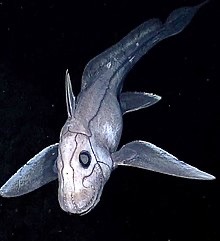
This little guy is just happy to be included. Just a little guy. Just a little buddy!
6. Gulper eel
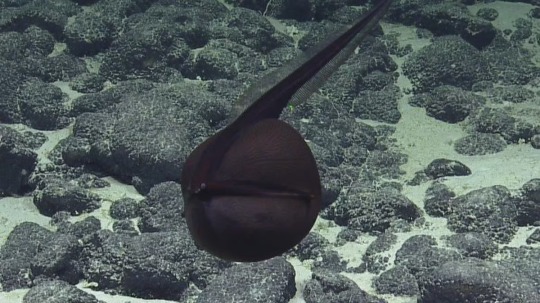
I love this fucker. He looks like a freaky shadow tadpole until you take a closer look and realize that his body is his whole mouth. He’s horrifying. 10/10.
5. Giant spider crabs

I don’t think I need to explain.
4. Vampire squid
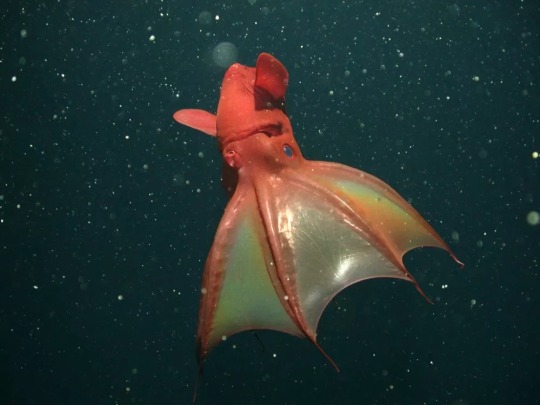
There are few things better than a nontraditional cephalopod. The vampire squid is shaped like your favorite umbrella and is the only known cephalopod to be a scavenger over fresh food.
3. Giant isopod
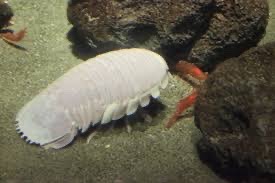
This is the second best invertebrate in the deep sea and no I will not be taking criticism today. He’s huge. He scuttles. He’s basically a giant rolypoly that’s too big to give a fuck about fuck. 13/10
2. Dumbo octopus

Friend-shaped and the most most adorable fucker you’ve ever seen in your life.
1. Coelacanth

The coelacanth is not only the best fish on this list but in fact the best fish in existence. The coelacanth was thought he extinct until one was pulled up by chance off the coast of South Africa I wanna say. Coelacanths are part of the clade sarcopterygii, the lobe-finned fishes, which includes two types of fish currently alive today: coelacanths and lungfishes. In fact, tetrapods (critters with legs, ie amphibians, reptiles, and mammals) evolved from certain species of sarcopterygians and basically we learned a metric fuckton about how tetrapods evolved by studying coelacanths.
Also they stand on their heads to feed and it’s delightful.
12454825273/10 best fish, best sea critter, everyone else can go home.
#sea life#fish#invertebrates#I will in fact be entertaining no arguments about this list#however you are welcome to justify your own faves#in fact please do so
160 notes
·
View notes
Text
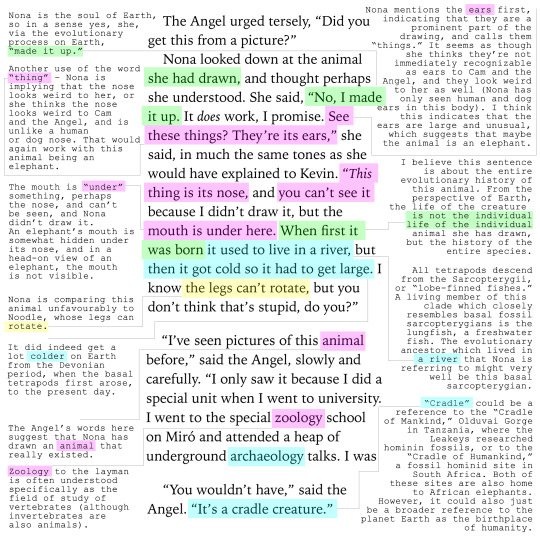
🐘 Is the "cradle creature" in Nona's drawing an elephant?
Image description and transcript:
Annotation of three quotes from Nona the Ninth. Areas with brackets have colour-coded annotations. The annotations will follow.
The Angel urged tersely, "Did you I get this from a picture?"
Nona looked down at the animal she had drawn, and thought perhaps she understood. She said, (“No, I made it up.) It does work, I promise. (See these things? They're its ears,") she said, in much the same tones as she would have explained to Kevin. ("This thing is its nose,) and (you can't see it because I didn't draw it, but the mouth is under here.) (When first it was born) (it used to live in a river, but then it got cold so it had to get large.) I know (the legs can't rotate,) but you don't think that's stupid, do you?"
"I've seen pictures of this (animal) before," said the Angel, slowly and carefully. "I only saw it because I did a special unit when I went to university. I went to the special (zoology) school on Miró and attended a heap of underground archaeology talks.
"You wouldn't have," said the Angel. "It's a cradle creature."
Nona is the soul of Earth, so in a sense yes, she, via the evolutionary process on Earth, “made [this creature] up.”
Nona mentions the ears first, indicating that they are a prominent part of the drawing, and calls them “things.” It seems as though she thinks they’re not immediately recognizable as ears to Cam and the Angel, and they look weird to her as well (Nona has only ever seen human and dog ears in this body). I think this indicates that the ears are large and unusual, which suggests that maybe this animal is an elephant.
Another use of the word “thing” [in reference to the nose] – Nona is implying that the nose looks weird to her, or she thinks the nose looks weird to Cam and the Angel, and is unlike a human or dog nose. That would again work with this animal being an elephant.
The mouth is "under" something, perhaps the nose, and can't be seen, and Nona didn't draw it. An elephant's mouth is somewhat hidden under its nose, and in a head-on view of an elephant, the mouth is not visible.
Nona is comparing this animal unfavourably to Noodle, whose legs can rotate.
I believe this sentence [“When first it was born…”] is about the entire evolutionary history of this animal. From the perspective of Earth, the life of the creature is not the individual life of the individual animal she has drawn, but the history of the entire species.
All tetrapods descend from the Sarcopterygii, or "lobe-finned fishes." A living member of this clade which closely resembles basal fossil sarcopterygians is the lungfish, a freshwater fish. The evolutionary ancestor which lived in a river that Nona is referring to might very well be this basal sarcopterygian.
It did indeed get a lot colder on Earth from the Devonian period, when the basal tetrapods first arose, to the present day.
The Angel's words here suggest that Nona has drawn an animal that really existed.
Zoology to the layman is often understood specifically as the field of study of vertebrates (although invertebrates are also animals).
"Cradle" could be a reference to the "Cradle of Mankind," Olduvai Gorge in Tanzania, where the Leakeys researched hominin fossils, or to the "Cradle of Humankind," a fossil hominid site in South Africa. Both of these sites are also home to African elephants. However, it could also just be a broader reference to the planet Earth as the birthplace of humanity.
420 notes
·
View notes
Text
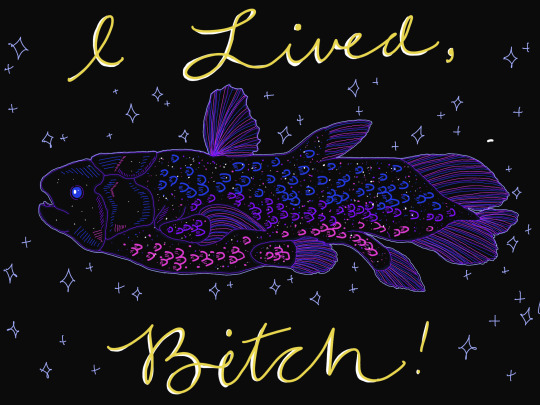
in my Fish Era à la Ray Troll. 🐟
coelacanths are my favorite bony fish (and yes that includes all tetrapods), and they're so fucking cool!! they're a member of clade Sarcopterygii (lobe-finned bony fishes), which also includes lungfish and tetrapods (including us humans)!
there are two species of coelacanth, one found in the waters off east africa and another found in indonesia. they live deep underwater (~100-500 m) and tend to spend the daytime in underwater caves, coming out at night to feed on small fish and cephalopods.
they were thought to be extinct by western scientists until 1938, though as often is the case the local indigenous people knew they were still around. they're often called a "living fossil" (not by me because i hate that term so much) and have some cool features only found in Sacropterygiians like cosmoid scales!
tldr: they're sick as fuck. :)
#coelacanth#fish#fish art#marine bio#marine biology#coelacanths#art#described#description in alt text
59 notes
·
View notes
Text
Okay!! I nearly went there and became a shark!
Next Question!!
Kinda exited what ya choose for me!!
17 notes
·
View notes
Note
favorite deep sea creature?
sorry this one took so long to answer. it's also very long. but I feel like you knew what you were getting into when you asked tumblr user "abyssalzones" what his favorite deep sea creature is.
now immediately my mind jumped to coelacanths because they're among my favorite fish Ever for a multitude of reasons, such as (but not limited to):
-their mystique (their fossilized ancestors were initially discovered in the 19th century, and due to their illusive nature were thought to have gone extinct at the end of the Cretaceous period until one was found alive by an unknown(?) fisherman off the coast of South Africa, and from there the discovery was accredited to museum curator Marjorie Courtenay-Latimar who spotted it in the day's catch. however it's worth mentioning fishermen in the eastern South African region may have known about the species before then. kind of a 'who can say if it wasn't written down' situation.)
-their beautiful blueness (others have waxed poetic about their appearance more skillfully than I, but just look at this guy. wow. albeit I have to wonder if how blue they appear is very dependent on lighting but whatever he's beautiful)

-and, finally, their importance as lobe-finned fish! (the two extant species of Coelacanth today- alongside lungfish, who are also incredibly cool- hold a unique position in taxonomy and evolutionary history as the only living non-tetrapod sarcopterygians that we know of ^_^ they used to be much more dominant as freshwater predators, but then the great dying came along and they suffered a significant decline. so, essentially, these guys are survivors! ...if you felt it necessary to frame it as such. and "sarcopterygian" more specifically describes them as belonging to the clade 'Sarcopterygii', which classifies them as lobe-finned bony fish. this contrasts the other clade of bony fish, Actinopterygii, which describes ray-finned bony fish. in essence, they are the great-great-great-great-ad-nauseum-grandparents of all tetrapods! very very important animals from a grander biological perspective.)
...however, after typing all of this out, I realize this is a little bit of a cop-out. Coelacanths, as cool as they are, are actually not the deepest of deep-sea fish. It's difficult to get the exact numbers on their whereabouts as, previously stated, they're pretty elusive guys, but generally during the daytime they're found about 100-500 meters deep, resting in caves and saving their energy for nocturnal reef-feeding. apparently they've been found to migrate deeper as well, but it still feels a little disingenuous (to me) to say that they're truly deep-sea animals.
...so if I want to live up to my username, I need to take you on a journey. to the abyssal zone. where you will find some truly terrifying, near-alien creatures, straight from the pits of Dante Alighieri's visions of hell, or Hieronymus Bosch's bizarre garden of earthly delights...!

no, not that guy! get him out of here. shoo.
Instead we're going to be talking about his big brother. his... very, very big brother.

okay so chances are you've seen this photo before, it circulates quite a bit online as "BIG FUCKING SCARY THING IN THE OCEAN" and it's pretty apparent why, but I'm incredibly fond of "Scary fucking thing in the ocean" in general, and as such I think this guy is delightful. I debated on picking a couple of different, lesser-known species from the abyssal-hadal range (such as various arctic amphipods), but if I'm honest I have a soft spot for cephalopods. typical, typical I know, I should be ashamed, but in this case I can safely say the Bigfin squid (genus Magnapinna) is anything but "typical".
oh, sure, there's a level of wonder healthily exacerbated by the rarity of sightings- but that's all we have! sightings and footage! well, that and washed-up corpses dating back to 1883, all being damaged juveniles that were never properly collected. even so, their significance and oddity isn't really made apparent until you see their adult form, which first came to science's attention properly in 2001 when some very grainy footage was captured by an oil drilling ship, the Milennium Explorer, in the gulf of Mexico.

he's shy.
I say "first came to science's attention" because the Bigfin had actually been recorded prior, all the way back to 1998, but no one had really gotten up out of their chair and started dancing around at the realization of holy shit, what is this thing? and from there further work was done on properly identifying and analyzing the species based on footage.
however... it's still just footage. there has not yet been a captured live specimen, nor a well-preserved cadaver, or... really anything to tell us more about this mysterious cephalopod, other than what we can tell visually and geographically. we know it sure looks distinctive compared to various species of squid (check out the elbows on that thing), we know the largest adult specimens seem to be about 25 feet long (with estimates going up to 40 feet), and we know it might be the deepest-occurring genus of squid (we've had sightings as deep as 6,212 meters below the surface- well into the hadal zone, actually, not just the abyssopelagic), but in terms of behavior? breeding? feeding habits?? there are a lot of unanswered questions. and that's not to discredit any legitimate scientific analysis, past or present, of the bigfin, but moreso to stress that it's a very mysterious creature we don't have much data on.
I think just in general, my favorite deep-sea creatures (and this extends to just about any species, sea-dwelling or otherwise) are those that do a very thorough job of not being found. I am driven by a deep curiosity into whatever is so weird and leads such an unimaginable life to us humans that it eludes the microscope or the scalpel time and time again.
oh, and bigfin squids kind of remind me of the alien controllers that fly around your head during the xen levels in half-life. so there's that as well.
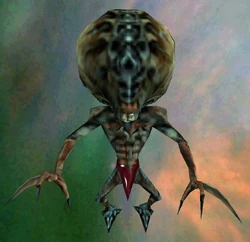

#lab notes#askbox#I am not by any means an expert so feel free to correct me if I'm wrong or misled about any of this!
5 notes
·
View notes
Note
Birds are class Aves.
Sure, under Linnaean taxonomy. But, well,
A) Linnaeus was a eugenecist so his scientific opinions are suspect and his morality is awful
B) he didn't know about evolution
C) he didn't know about prehistoric life
so his classification system? Sucks ass. It doesn't work anymore. It no longer reflects the diversity of life.
Instead, scientists - almost across the board, now - use Clades, or evolutionary relationships. No rankings, no hierarchies, just clades. It allows us to properly place prehistoric life, it removes our reliance on traits (which are almost always arbitrary) in classifying organisms, and allows us to communicate the history of life just by talking about their relationships.
So, for your own edification, here's the full classification of birds as we currently know it, from biggest to smallest:
Biota/Earth-Based Life
Archaeans
Proteoarchaeota
Asgardians (Eukaryomorphans)
Eukaryota (note: Proteobacteria were added to an asgardian Eukaryote to form mitochondria)
Amorphea
Obazoa
Opisthokonts
Holozoa
Filozoa
Choanozoa
Metazoa (Animals)
ParaHoxozoa (Hox genes show up)
Planulozoa
Bilateria (all bilateran animals)
Nephrozoa
Deuterostomia (Deuterostomes)
Chordata (Chordates)
Olfactores
Vertebrata (Vertebrates)
Gnathostomata (Jawed Vertebrates)
Eugnathostomata
Osteichthyes (Bony Vertebrates)
Sarcopterygii (Lobe-Finned Fish)
Rhipidistia
Tetrapodomorpha
Eotetrapodiformes
Elpistostegalia
Stegocephalia
Tetrapoda (Tetrapods)
Reptiliomorpha
Amniota (animals that lay amniotic eggs, or evolved from ones that did)
Sauropsida/Reptilia (reptiles sensu lato)
Eureptilia
Diapsida
Neodiapsida
Sauria (reptiles sensu stricto)
Archelosauria
Archosauromorpha
Crocopoda
Archosauriformes
Eucrocopoda
Crurotarsi
Archosauria
Avemetatarsalia (Bird-line Archosaurs, birds sensu lato)
Ornithodira (Appearance of feathers, warm bloodedness)
Dinosauromorpha
Dinosauriformes
Dracohors
Dinosauria (fully upright posture; All Dinosaurs)
Saurischia (bird like bones & lungs)
Eusaurischia
Theropoda (permanently bipedal group)
Neotheropoda
Averostra
Tetanurae
Orionides
Avetheropoda
Coelurosauria
Tyrannoraptora
Maniraptoromorpha
Neocoelurosauria
Maniraptoriformes (feathered wings on arms)
Maniraptora
Pennaraptora
Paraves (fully sized winges, probable flighted ancestor)
Avialae
Avebrevicauda
Pygostylia (bird tails)
Ornithothoraces
Euornithes (wing configuration like modern birds)
Ornithuromorpha
Ornithurae
Neornithes (modern birds, with fully modern bird beaks)
idk if this was a gotcha, trying to be helpful, or genuine confusion, but here you go.
all of this, ftr, is on wikipedia, and you could have looked it up yourself.
671 notes
·
View notes
Text
Fish Taxonomy
The term fish is commonly used to refer to members of Actinopterygii (ray-finned fish, mostly what people think of when they imagine fish)and Chondrichthyes (cartilaginous fish, the sharks, rays, etc, and chimeras). It is also used for Sarcopterygii (lobe-finned fish, the coelacanths and lungfish) and Agnatha (jawless fish, the hagfish and lampreys), although people don’t talk about lobe-finned and jawless fish as much as they do ray-finned fish and sharks. Tetrapoda (four-limbed vertebrates) is nested within Sarcopterygii, and mostly contains animals which traditionally have not been considered fish (you, me, your cat, the chicken eating your popcorn, the frog hopping away from the chicken). In modern cladistics, this is a little bit of an issue, because the common use of fish as described above is paraphyletic, i.e. it does not include all of the descendants of the group’s last common ancestor. Here are some different ways this issue can be resolved.
Option 1: Fish is not a cladistic term, and therefore we don’t need to worry about whether it’s a good and well formed clade. Reasonable and understandable, we have loads of scientific terms to unambiguously talk about groups of animals, but also boring. Play with me in this space!
Option 2: Fish includes Osteichthyes (Actinopterygii plus Sarcopterygii), Chondrichthyes, and Agnatha, therefore it is essentially synonymous with Vertebrata. You, me, and Moby Dick are all joyfully fish (Melville was right!) (and also a fish). Is this really helpful? Maybe not, but it’s fun.
Option 3: Fish is not a cladistic term, it’s a non-scientific term used to refer to any animal that lives in the water. Jellyfish are fish, starfish are fish, dolphins are fish, humans are not fish, why would you ever suggest such a silly thing?
Option 4: Fish is essentially synonymous with Vertebrata, so why not expand that to all of Chordata? Tunicata and Cephalochordata are welcomed into the Fish Club.
Option 5: Fish is a lifestyle. In the same way that a tree is any plant that gets tall and kinda woody, a fish is an obligate aquatic animal that actively swims. Salmon are fish, tadpoles are fish, frogs are not fish, sea stars are not fish, porpoises are fish, octopuses (-pi, -podes) are fish, most gastropods are not fish, but Phylliroe is absolutely a fish.
Option 6: Fish comes from the Proto-Indo-European root *peysḱ- (“fish”), which is probably derived from *peyt- (“to feed, to guard, to nourish”), and is cognate to lots of words having to do with food (Sanskrit पितु (pitu, “food”), Lithuanian piẽtūs (“lunch”), etc), so if someone asks you “is this a fish?” you must slap it on the grill, maybe squeeze some lemon on it, and find out for yourself.
38 notes
·
View notes